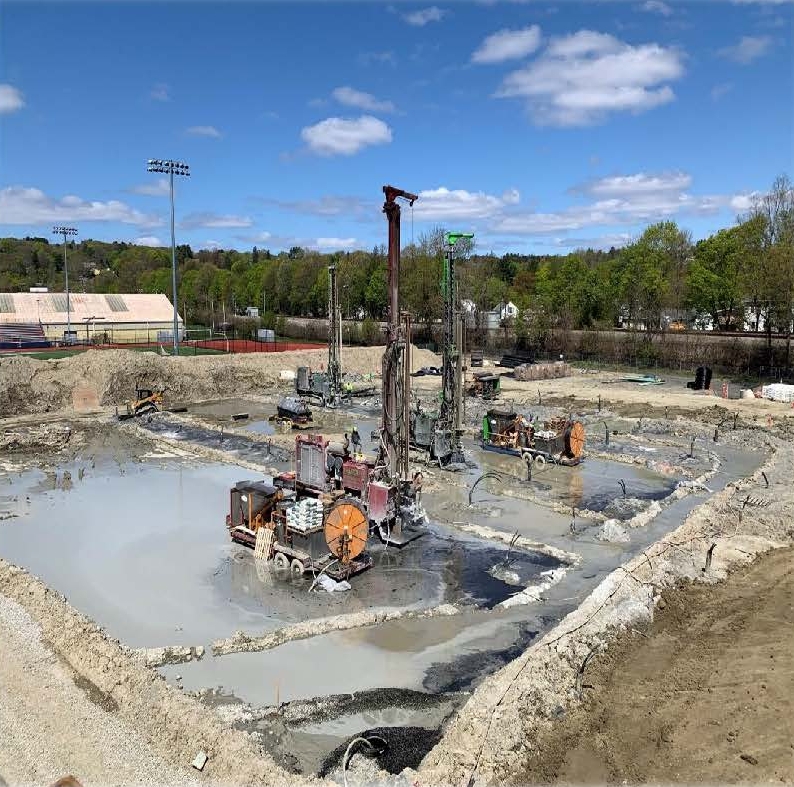School Building Committee Reviews HVAC Options

Ground source heat pump (geothermal) well field installation at the Belmont Middle and High School. Photo: Massachusetts School Building Authority
The Elementary School Building Committee (ESBC) will not be making the decision between a ground versus air sourced heat pump system for the new elementary school until later this summer. The committee needs to secure the Amherst Board of Health’s permission to drill test wells and the drilling companies that the designers are comfortable with are scheduling out to the end of this summer. In addition, the designer (DiNisco) indicated that Eversource is about to announce a new “generous” incentive program (“GSHP Heat Pump Adder”) for geothermal systems.
The Net Zero Subcommittee was joined by several members of the DiNisco Design team and their engineering consultants from Thornton Tomasetti at their July 6 meeting to compare and contrast ground and air source heat pumps (GSHP and ASHP). Presentation materials are available here.
Both systems are all electric but include a generator on-site for back-up. The ground source system’s higher upfront costs are offset by both lower operating, maintenance, and photovoltaic costs, as well as anticipated incentives available for initial installation. The air source system would require a dedicated preheating unit for domestic hot water, specialty maintenance for the refrigerant system, and would use ducted fan coil units in classrooms rather than the chilled beam units planned for the ground source system. The ground source system is noted to be extremely quiet, although the air sourced system is quieter than the traditional units.
The engineers described the energy modeling they will be using, which accounts for different room types and thermal zones and follows ASHRAE 209-2018 guidelines. The current thermal envelope assumptions (window to wall ratio of 23%, R-40 for the roof, and R-25 for the walls) may be modified in ground versus air sourced modeling to compensate for the lower Energy Use Intensity expected (i.e. more energy efficiency) with the ground source system. Any adjustments here would add to upfront costs to the air source model.
DiNisco team members pointed out that the Life Cycle Cost Analysis (LCCA) done on both systems represent the capital costs only, not maintenance costs. According to Designer Donna DiNisco, the anticipated “GS Heat Pump Adder” incentive, not yet included in the cost analysis, could cover nearly the entire difference in capital costs between the two systems. DiNisco said that they would post information on this program as soon as it becomes available; inquiries by the Indy at time of the writing of this article revealed no updates as yet.
There are other differences between the two systems. The GSHP is expected to achieve the ESBC’s goal of an EUI of 25, which is then eligible for additional utility incentives. Refrigerants, of interest for environmental impacts because of the potential leakage of greenhouse gasses, are only used by the GSHP system in the mechanical room, as opposed to throughout the building in the ASHP system.
A vote to recommend GSHP versus ASHP is on the agenda for
the Net Zero Subcommittee’s next scheduled meeting on August 4 at 1pm. Meeting packet materials are not yet available but can be sought here.

The many benefits enumerated here for a ground source heat pump system are further enhanced by the quality of the Fort River site itself: a large, easily-accessed area for ground coupling, combined with an expectation for deep clay and gravel soils with minimal near-surface bedrock.
And if the subsurface geology pans out as expected, there may be an opportunity to go beyond providing a geothermal energy source for the school itself: nearby residential and commercial buildings could also benefit from the “local utility” a Fort River geothermal system would afford.
This could make the project even more attractive to Eversource, and lead to additional financial benefits to the Amherst Schools and the Town if thoughtfully planned and managed.
These potential broader benefits should be kept in mind as the planning moves forward.
UPDATE REGARDING EVERSOURCE INCENTIVE FOR GSHP
A document was recently posted to the Net Zero SubComittee’s packet for this coming Thursday’s meeting (8/4/22). It is an email from a member of the DiNisco Design team indicating that Eversource’s GSHP “Heat Pump Adder” incentive has indeed increased substantially. See the following link:
https://www.amherstma.gov/DocumentCenter/View/62774/Eversouce-Incentives-Email-72522
For the Amherst project, the incentive would amount to more than $1.6 million if the building uses the ground source system and the anticipated goal EUI of 25 is reached. This, plus the need for significantly fewer solar panels in a ground source system, would nearly offset the entire difference in initial capital costs between the ground and air source systems.